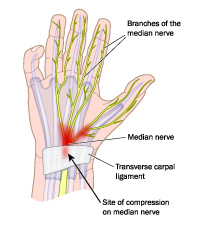Use our convenient online scheduler to book an appointment now.

Do you have a job that requires repetitive hand use or extreme wrist flexion? Have you recently been feeling pain, numbness, or lack of function in your hand and wrist? If so, you might be experiencing symptoms of carpal tunnel syndrome (CTS).
You wouldn’t be alone either. It’s estimated that between 3 and 6% of the adult general population suffers from this condition. Keep reading to learn about the causes, symptoms, and treatment of carpal syndrome, and how the expert physicians at Town Center Orthopaedics can restore you to full function.
What is Carpal Tunnel Syndrome?
Carpal tunnel syndrome is the most common form of what is known as entrapment neuropathy (more simply called nerve entrapment). This happens when a nerve loses flexibility or mobility, or is compressed by the surrounding tissue. This can occur all over the body, with many of the common instances occurring in the shoulder and elbow, or the hand and wrist.

Carpal tunnel syndrome affects, unsurprisingly, the carpal tunnel of the wrist. But what is that actually?
Carpals are the eight small bones at the base of the hand that make up the wrist structure. These bones serve as the floor and sides of the Carpal tunnel enclosed with a ligament roof. Running between these bones and ligament are several tendons and the median nerve. When there is inflammation in this region, the tendons swell and take up more room. This then causes pressure onto the nerve and you feel numbness and/or tingling in your hand which are the classic carpal tunnel symptoms.
What Causes Carpal Tunnel Syndrome?
Now that we know basis of the carpal tunnel syndrome, we can talk about what actually causes the condition. However, even this isn’t so simple. There are numerous risk factors associated with carpal tunnel syndrome. While the following may not be a direct cause, they may contribute to damage and irritation of the median nerve:
Trauma
- Wrist fractures and dislocations can deform the space in the carpal tunnel, putting pressure on the median nerve.
Workplace Factors
- As mentioned at the beginning of the article, repetitive hand use or extreme wrist use can cause stress that over time can lead to chronic inflammation.
Nerve-Damaging Conditions
- Some chronic illnesses like diabetes increase the risk to the median nerve, causing CTS.
Inflammatory Conditions
- Arthritis and other inflammatory conditions can put pressure on the carpal tunnel, compressing the median nerve.
Sex
- Women are three times more likely to suffer from CTS than men. This is particularly true in women with smaller wrists.
- Pregnancy and carpal tunnel are also connected, due to increased blood volume causing inflammation. This further contributes to the difference by sex.
Other conditions
- Various other conditions such as menopause, thyroid disorders, kidney failure, and lymphedema may also be linked to CTS.
What are the Symptoms of Carpal Tunnel?
Typically, carpal tunnel symptoms begin gradually, often with no specific triggering injury. As the condition worsens, symptoms often occur with increasing frequency, and for longer periods of time. Symptoms include:
- Burning, tingling, pain, and numbness in the fingers
- Primarily index, middle, and ring fingers
- Pain and tingling through the arm
- The feeling may travel up the forearm through the shoulder
- Sensations like electric shocks radiate through the fingers
- Commonly the thumb, pointer, middle, and ring fingers
- Weakness and loss of mobility
- Inability to execute fine motor functions like buttoning clothes
- Dropping objects involuntarily due to weakness in hand and wrist
What are the Treatments for Carpal Tunnel?
Conservative Treatments
Before surgery is ever considered, the expert doctors and occupational therapists at Town Center Orthopaedics will try every non-surgical option. These treatments may include:
Lifestyle changes
- Break up repetitive motion with breaks, or reduce the activity that causes pain
Physical and Occupational Therapy
- Stretching and strengthening exercises can help alleviate symptoms.
- Nerve gliding exercises can alleviate the effects of compression
Carpal Tunnel Brace or Splint
- Immobilization can get rid of the numbness and tingling sensations
Over-the-Counter Drugs
- Your doctor may prescribe non-steroid drugs like ibuprofen, aspirin, and other anti-inflammatory options.
Steroid Injection
- Steroid shots into the affected area can reduce swelling, and allow you to return to normal activity.
Surgical Treatments

If conservative treatments would not be appropriate for your needs, or prove to be ineffective after multiple attempts, a Town Center Orthopaedics specialist may recommend surgery. The surgery is often required on both hands, but is still an outpatient procedure with no overnight stay required. Due to the prevalence of CTS, the corresponding surgery is one of the most common procedures in the United States.
During the procedure, the ligament roof over the tendons and median nerve cut, opening the carpal tunnel and alleviating pressure. The procedure can be performed as either an open-release surgery or as an endoscopic procedure. Some conditions are best to have the surgery through the traditional open approach and others are served best with an endoscopic approach. Your doctor will consider your unique situation to determine which option is right for you.
How Long is Carpal Tunnel Surgery Recovery?
Recovery from Carpal tunnel surgery is two fold. One from the wound made during surgery and then from your nerve compression symptoms. Your wound typically takes 2-3 weeks to heal on average. Your nerve symptoms will depend on the severity of your condition. By releasing the ligament roof of the carpal tunnel, your nerve will now have more breathing room. We give the nerve 12 months to show us how it will recover. Releasing the carpal tunnel ligament roof gives your nerve more room and protects it from further compression. This makes our top reason to do surgery is preventing your symptoms from getting any worse. The physicians and occupational therapists at Town Center Orthopaedics will work with you to ensure your recovery is as quick as possible.

Patients will spend the first 7-10 days following surgery with soft bandages. During this time they are encouraged to move their fingers to prevent stiffness. Once this period is over, they begin occupational therapy to regain mobility and strength in the hand and wrist. Continuing to practice your occupational therapy exercises in accordance with your doctor’s orders is vital for your recovery.
Don’t Wait to Get the Care You Deserve
If hand and wrist pain is keeping you from doing the things you love, don’t wait to get help! Not only is treatment safe, easy, and effective, but acting now keeps the situation from getting worse. To learn more about how Town Center Orthopaedics can get you back to living your best life, schedule an appointment today or call (571) 250-5660.
Join our Mailing List
TCO provides patients with orthopedic problems the trusted resources and patient-centered advice they need to “Feel Better. Move Better. Be Better.”
© 2024 Town Center Orthopaedics | All Rights Reserved


